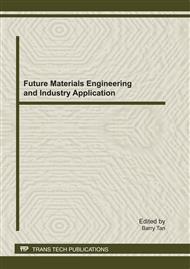[1]
Andrew N. Cohen and James T. Carlton, Accelerating invasion rate in a highly invaded estuary, Science, vol. 279, no. 5350, p.555–558, (1998).
DOI: 10.1126/science.279.5350.555
Google Scholar
[2]
Carlton J. T., "Introduced Species in US Coastal Waters: Environmental Impacts and Management priorities (Arlington, VA: Pew Oceans Commission), (2001).
Google Scholar
[3]
Bax N, Williamson A, Aguero M, Gonzalez E and Geeves W, Marine invasive alien species: a threat to global biodiversity, Mar. Policy, vol. 27 p.313–23, (2003).
DOI: 10.1016/s0308-597x(03)00041-1
Google Scholar
[4]
Peter M. Vitousek, Harold A. Mooney, Jane Lubchenco, and Jerry M. Melillo, Human domination of earth's ecosystems, Science, vol. 227, p.494–499, (1997).
DOI: 10.1126/science.277.5325.494
Google Scholar
[5]
Ruiz G. M., Miller A. W., Lion K., Steves B., Arnwine A. and Collinetti E., First biennial Report of the National Ballast Information Clearhouse Status and Trends of Ballast Water Management in the United States (MD, USA: Smithsonian Environmental Research Center), (2001).
DOI: 10.5479/data.serc.nbic
Google Scholar
[6]
Gray D K, Johengen T H, Reid D F and MacIsaac H J, Efficacy of open-ocean ballast water exchange as a means of preventing invertebrate invasions between freshwater ports Limnol, Ocean Ogr., vol. 52, p.2386–2397, (2007).
DOI: 10.4319/lo.2007.52.6.2386
Google Scholar
[7]
McCollin T, Shanks A M and Dunn J., The efficiency of regional ballast water exchange: changes in phytoplankton abundance and diversity Harmful Algae, vol. 6, p.531–546, (2007).
DOI: 10.1016/j.hal.2006.04.015
Google Scholar
[8]
Tang Z J, Michael A B and Xie Y F., Crumb rubber filtration: a potential technology for ballast water treatment, Mar. Environ. Res, vol, 61, p.410–423, (2006).
DOI: 10.1016/j.marenvres.2005.06.003
Google Scholar
[9]
Rigby G R, Hallegraeff G M and Sutton C. Novel ballast water heating technique offers cost-effective treatment to reduce the risk of global transport of harmful marine organisms, Mar. Ecol. Prog. Ser., vol. 191, p.289–93, (1999).
DOI: 10.3354/meps191289
Google Scholar
[10]
Rigby G. R, Hallegraeff G. M. and Taylor A. H., Does heat offer a superior ballast water treatment option?, J. Mar. Environ. Eng., vol. 7, p.217–30, (2004).
Google Scholar
[11]
Waite T. D. et. al, Removal of natural populations of marine plankton by a large-scale ballast water treatment system, Mar. Ecol. Prog. Ser., vol. 258, p.51–63, (2003).
DOI: 10.3354/meps258051
Google Scholar
[12]
Tamburri M. N., Kerstin W. and Masayasu M., Ballast water deoxygenation can prevent aquatic introductions while reducing ship corrosion, Biol. Conservation, vol. 103, p.331–341, (2002).
DOI: 10.1016/s0006-3207(01)00144-6
Google Scholar
[13]
McCollin T., Quilez-Badia G., Josefsen K. D., Gill M. E., Mesbahi E. and Frid C. L. J., Ship board testing of a deoxygenation ballast water treatment, Mar. Pollut. Bull. vol. 54, p.1170–1178, (2007).
DOI: 10.1016/j.marpolbul.2007.04.013
Google Scholar
[14]
Perrins J. C., Cooper W. J., (Hans) van Leeuwen J. and Herwig R. P., Ozonation of seawater from different locations: formation and decay of total residual oxidant—implications for ballast water treatment, Mar. Pollut. Bull. vol. 52, p.1023–1033, (2006).
DOI: 10.1016/j.marpolbul.2006.01.007
Google Scholar
[15]
Oemcke D. and (Hans) van Leeuwen J., Ozonation of the marine dinoflagellate alga Amphidinium trochoidea—implications for ballast water disinfection, Water Res., vol. 39 p.5119–5125, (2005).
DOI: 10.1016/j.watres.2005.09.024
Google Scholar
[16]
Oemcke D. and (Hans) van Leeuwen J., Seawater ozonation of Bacillus subtilis spores: implications for the use of ozone in ballast water treatment, Ozone: Sci. Eng., vol. 26, p.389–401, (2004).
DOI: 10.1080/01919510490482241
Google Scholar
[17]
D. A. Wright, R. Dawson, S. J. Cutler, H. G. Cutler, C. E. Orano-Dawson and E. Graneli, Naphthoquinones as broad spectrum biocides for treatment of ship's ballast water: toxicity to phytoplankton and bacteria, Water Res., vol. 41, p.1294–1302, (2007).
DOI: 10.1016/j.watres.2006.11.051
Google Scholar
[18]
M. Faimali, F. Garaventa, E. Chelossi, V. Piazza, O. D. Saracino, F. Rubino, G. L. Mariottini. and L. Pane, A new photodegradable molecule as a low impact ballast water biocide: efficacy screening on marine organisms from different trophic levels, Mar. Biol., vol. 149, p.7–16, (2006).
DOI: 10.1007/s00227-005-0207-y
Google Scholar
[19]
Gregg M. D. and Hallegraeff G. M., Efficacy of three commercially vailable ballast water biocides against vegetative microalgae, dinoflagellate cysts and bacteria, Harmful Algae, vol. 6, p.567–584, (2007).
DOI: 10.1016/j.hal.2006.08.009
Google Scholar
[20]
Chelossi E. and Faimali M., Comparative assessment of antimicrobial efficacy of new potential biocides for treatment of cooling and ballast waters, Sci. Total Environ., vol. 356, p.1–10, (2006).
DOI: 10.1016/j.scitotenv.2005.03.018
Google Scholar
[21]
Sato M., Tokita K., Sadakata M., Sakai T., and Nakanishi K., Sterilization of microorganisms by a high-voltage, pulsed discharge under water, Int. Chem. Eng. vol. 30(4), p.695 – 698, (1990).
DOI: 10.1252/kakoronbunshu.14.556
Google Scholar
[22]
T. Grahl and H. Märkl, Killing of microorganisms by pulsed electric fields, Applied microbiology and biotechnology, vol. 45, PP. 148-157, (1996).
DOI: 10.1007/s002530050663
Google Scholar
[23]
Sale A.J.H. and Hamilton W.A., Effect of high electric fields on microorganisms, Biochem. et Biophys. Acta, vol. 148, p.781, (1968).
Google Scholar
[24]
Sakurauchi Y. and Kondo E., Lethal effect of high electric fields on microorganisms, Nippon Nogei Kagaku Kaishi, vol. 54, pp.837-844, (1980).
Google Scholar
[25]
S. E. Gilliland and M. L. Speck, Inactivation of microorganisms by electrohydraulic shock, Appl Environ Microbiol., vol. 15, pp.1031-1037, (1967).
DOI: 10.1128/am.15.5.1031-1037.1967
Google Scholar
[26]
Chih-Wei Chen, et. al, Influence of pH on inactivation of aquatic microorganism with a gas- liquid pulsed electrical discharge, Journal of electrostatics, vol. 67, pp.703-708, (2009).
DOI: 10.1016/j.elstat.2009.03.008
Google Scholar
[27]
Nyein Nyein Aye, Sun Bing, Xiaomei Zhu, Zhiying Gao, Masayuki Sato, Inactivation of algae in ballast water with multi-needle gas-liquid hybrid discharge reactor, ESIAT 2010 International conference, vol. 3, pp.28-31, (2010).
DOI: 10.1109/esiat.2010.5568936
Google Scholar


